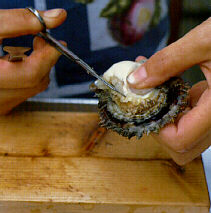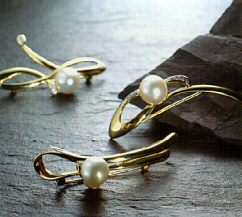
 |
The Akoya cultured pearl derives from oysters coming mainly from the southern and western portions of the Japanese islands. The Akoya oyster, or pinctada martensi fucata, was first discovered in the mid 1800s and later successfully cultivated by the Japanese at the turn of the century. Pearl farmers have three basic requirements to begin the process of forming an Akoya cultured pearl: a mature oyster ripe for seeding, a piece of mantle tissue from another healthy oyster, and the nucleus. The mother oyster is the Akoya, a small and delicate mollusk whose shell grows to a diameter of only about seven centimeters at maturity after approximately three years of growth. Seeding takes place during the warmer months, from April to August. Akoya oysters are harvested in winter. Despite the farmer's diligence, there is no guarantee that a perfect, round pearl will be in any but a small percentage of the oysters. Some may contain no pearl at all. Others may contain pearls which are less desirable, some even unusable. The harvested Akoya pearls, known at this stage as "hama-age," are washed and sorted into broad categories. They are weighed in momme, an ancient Japanese unit equaling 3.75 grams, and then auctioned off to pearl processors. Because of the large worldwide demand for necklaces, a high percentage of Akoya cultured pearls are strung into uniform chokers or graduated strands. The rest find their way into individual pieces such as rings, earrings, brooches, tie pins and other types of fashionable jewelry. |  
|